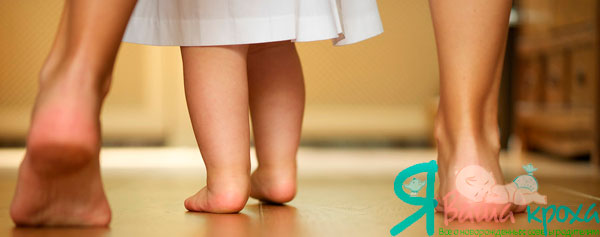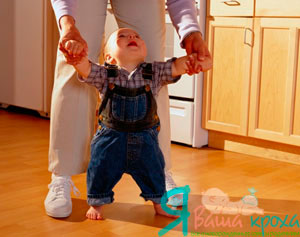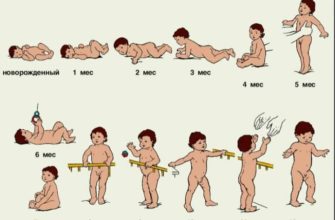Your child is growing, developing, already creeping in full, and each parent is waiting for the moment when their baby begins to walk on its legs, will take the first step. Many parents try to help their baby to go and try to teach the child to walk independently as quickly as possible. Let's figure out when to start preparing. We bring to your attention 10 simple tips that we hope will help you.

We already wrote a detailed article about when children begin to walk, we recommend that you familiarize yourself (to have a general idea).
The beginning of time
№1 Lie on the tummy
Long before your baby takes his first steps, when he is only a few weeks old, you can begin to prepare his muscles for the upcoming work. Make sure the child spends 10 minutes a day on the tummy, either immediately or throughout the day. This action will help strengthen the neck and back muscles of the baby. (We read: How to lay the baby on the tummy).
№2 Practice flipping
Get ready for somersaults while changing diapers! The child will begin to roll over from side to side and try to return back as early as two to four months of age. Encourage his coups by holding the toy first above him, and then moving it to the side to the limit. This will help the baby develop the muscles of the neck, back, legs and arms, prepare for the next step: the ability to sit. (We read: When the baby starts rolling over | We teach the baby to turn over in 3 - 4 months: simple acting exercises (+ video)).
№3 Encourage movement
Starting from about 4 months of age, the child tries to sit with support or in pillows, and at 6 months he is able to sit alone. Help him sit by gently pulling the handles. Stimulate the baby to turn in different directions, lean, sit with the help of a toy, leaving it out of reach, strengthening its muscles and coordination.
№4 Set off on a journey
 From six to ten months, the baby will learn to crawl, lunging forward for the subject that caught his attention. Take advantage of this and place objects attractive to him away, encouraging movement. Take a little trip around your home using your child’s newfound mobility. Article about the initial period of crawl.
From six to ten months, the baby will learn to crawl, lunging forward for the subject that caught his attention. Take advantage of this and place objects attractive to him away, encouraging movement. Take a little trip around your home using your child’s newfound mobility. Article about the initial period of crawl.
№5 Help strengthen leg muscles
Your curious little pean will soon begin to get up, leaning on various objects, such as furniture, your foot, or anything else, in order to maintain balance. Usually children cope with this task in seven to twelve months. Help strengthen their leg muscles, allowing you to hold on to you, jump on your knees. Also teach your baby to bend his knees so that he knows how to get back on the floor.
First steps
№6 Be a companion
When the child is gaining strength and is already well, he begins to move around the house, holding on to furniture and other objects. Now is a good time to go on a “cruise” again when it has reached new heights. To teach a child to walk well, support him, hold his hands and walk with him. This is also an ideal time to give him a pushing toy, such as a stroller for a doll, which will help him walk independently or a car with a handle.

№7 Forget the walkers
It is not necessary, and even harmful, to accustom the baby to walkers. They can delay the development of the child in the ability to walk, because they narrow his hips and pelvis. In addition, walkers are sometimes dangerous, babies can roll up to the heater, stove, stairs or pool while in them. It seems that this design can make life easier for mom. But this is not so. One must constantly observe whether something has happened. Try to better use a stationary table for your baby’s games.
We recommend that you read the article on walkers (Disputes “FOR” and “AGAINST” walkers)
You can also read about jumpers at the same time. – to use jumpers or not
№8 Choose interesting places to walk
Finally the moment has come that you have been waiting for so long: the child let go of the walls, furniture, hands and took the first steps on his own.Most children take their first steps from nine to thirteen months, and begin to walk confidently between fourteen and fifteen months of life. Now, as he goes, get ready to see new amazing moments: how he kicks the ball or scrambles up, down the stairs.
Video No. 1: How to teach a child to walk independently
Top, top, the baby is stomping ... The first steps are not very easy ... The baby looks touching, which, shifting from leg to leg, takes its first steps. Walking is another small discovery in a child’s life.
№9 Do not compare
Not all children are the same. Some succeed earlier, others later. The time a child needs to reach a certain milestone may depend on various reasons, such as body weight or even character. Although this is not easy, try not to be disappointed or upset if your child is behind other children. Keep in mind that the dates are approximate and not carved in stone.
№10 Choose the right shoes
Go buy the first pair of walking shoes at the end of the day, when the foot is slightly larger than in the first half. Let the baby dress and stand in new shoes. Make sure that it is spacious for him, not crush. Let him walk around the store a bit, check for irritation, red spots on the legs. If there are stains, try a larger size. Shoes should be strictly age-appropriate, have a solid high heel, an elastic sole with an arch support, a comfortable fastener. In detail about the right choice of children's shoes.
At home you can walk without shoes, it is useful, tempers. If you are afraid that the baby will slip, buy socks with a rubberized sole. They will also prevent flat feet.
Walking problems
If a child falls very often when walking, constantly wants to walk only holding on to your hand, then one of the possible reasons may be poor eyesight, we recommend that you consult an optometrist.
Read additional tips on your child’s development.
It happens that a child walks not on his whole foot, but on tiptoe, many parents do not understand why their baby walks on toes, so check out the article — reasons and what to do?
Updated:Another popular problem is when the child is afraid to walk on his own, so read why he is afraid and what should be done in this case – link to article
Video No. 2: The child refuses to walk independently
Video answer to the question:
"Hello! The daughter started walking at 11 months, she took several steps without support, then fell slightly and flatly refuses to walk on her own, only by the handle, and she can barely hold on to her finger, or lean on furniture, etc. In a year, they underwent examination, everything was fine, the neurologist looked at the orthopedist, a little hallux valgus feet, went through a massage course - no changes, we run, we rush for the handle. It is worth contacting a neurologist or psychologist, or not touching a child, how will it go, will it? Perhaps there are some special psychological techniques or games to overcome this fear? Thank you in advance for your reply. ”
The conclusion is:
- Do not rush the child.
- Develop interest in walking.
- Find an example to follow.
- Hold correctly.
- Refusal of "walkers".
- Walking without shoes.
Important! We also read: Children grow up very fast. Within a few months, your child will stop lying in the crib, begin to crawl, then walk, develop new territories first in his room, and then throughout the house, so it is very important to protect the house for the child. How to do it right, read in this article - how to secure a home for a small child
Learning to walk: video number 3:
Very useful video. Highly recommended for viewing!
Interview with a physician for physiotherapy exercises (video No. 4)
The first children's steps. What time should a child start walking? Answers Varvara Vladimirovna:
Patience to you, wisdom and happiness!
Updated:
Thesis:
- Do not rush your child. All averages are conditional. Therefore, even at 14-15 months it’s still not normal for some to walk independently. The main task of parents at the initial stage is to wait until the child is ripe for the development of a new skill. Haste can adversely affect the formation of feet, muscles, and joints.
- To create a favorable, safe environment: remove everything that could be harmful, eliminate sharp corners, hide the cords, and especially carefully monitor the baby.
- Conduct physical training. No special exercises are required. You just need to train all muscle groups from birth on time in a timely manner. Spread on the stomach, stimulate turning. Next, the child himself should sit down from a prone position. And, of course, crawling plays a big role. The task of the parent in every way to encourage the motor activity of the child. For example, attracting him with toys, forcing him to crawl around the room. And jumping on the parent's lap, which children love so much, is an excellent exercise to strengthen the legs. (How to make a newborn baby stronger: 4 basic exercises for developing strength and endurance in a baby)
- Massage develops muscles well and relieves tension in them at the same time. You can contact a specialist, and you can do it yourself.
- Encourage walking. You can show an amusing toy, and then put it on the table, for example, so that you could get it only by standing on your feet. When the baby tries to take the first steps, the toy can miraculously move from the table to the sofa as soon as the baby approaches it. It’s good to be outside more often. where you can watch other children who already know how to walk. In this case, it is better to leave the stroller at home. It’s convenient to use special reins. But only when the child is already starting to walk. It is important to ensure that the child’s body does not bend forward or to the side.
- Encourage. Praise for success, a smile of mom and dad is the best reward. Do not forget about the gentle and enthusiastic words. The child deserves this for his first steps.
Things to remember when teaching a child to walk:
- Better to start walking barefoot. This leads to the correct formation of the foot. And along the way tempers the baby. Well, or wear socks with a rubber sole.
- For walks on the street, you should purchase high-quality and comfortable shoes with a tight backdrop and make sure that it does not rub the legs.
- No need to be tempted walkers. Children often after a walker for a long time walk on toes. And they completely refuse to learn walking skills in a timely manner.
- During training, you do not need to hold the child by the armpits. More correct for the brush, for the forearm, or even for the hood.
- And, most importantly, be patient. Do not fit the child under the standard framework. But you need to be an assistant to him in everything, as soon as he himself is ready for new discoveries.









I don’t know about all these methods, if the child wants to walk, then he can’t stop him and he doesn’t need company or medical shoes. I think all this will come in handy in the future, at a conscious age.
Praise to the author, step by step sensible, I understood everything with pleasure, there is one caveat - there is no author’s position (I got acquainted with the article on walkers) you still have to decide for yourself. After all, the site gives advice ...
Interesting ways to teach a child. We had everything in a different way: crawled for a long time, skated, did not go walking, got up and fell. Then he took it and began to run sharply. Everything is individual for everyone, let the child want to walk himself and everything will be ok.
In my opinion, there is no need to try to activate the process of child development. Everything has its own time, and when it is necessary, the child will run, even stopping it will be difficult. But then parents will already need a lot of attention, and appropriate shoes. We took shoe for our little son in Borsellino for the smallest - it turned out to be really high quality, soft and comfortable. Now ours is already running, I think shoes play an important role here.
After saying that from 4 months the child learned to sit on his own or in the pillow, she did not even read further. From 4 months. In the pillows. And what not with two?